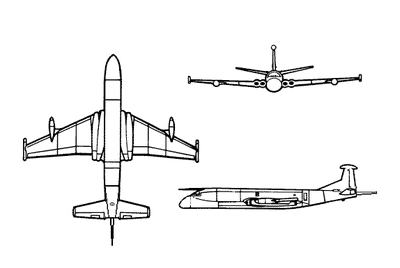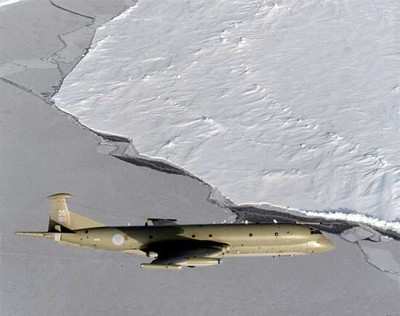MoD Accused Of Ignoring "Issues"
Nimrod spy planes are aptly named, according to a story in the
Guardian Observer. A dozen major deficiencies in the repair and
maintenance of the RAF's Nimrod spy planes were recognized the UK
Military Defense officials shortly before one of the aircraft
exploded above Afghanistan, killing 14 people, causing the biggest
loss of life suffered by Britain's armed forces since the Falklands
war.

An internal defense report examined by the Observer highlights a
catalogue of 'critical' failings found during an investigation into
the recurrent problem of fuel leaks within the Nimrod fleet.
Concerns relating to a 'low standard of workmanship' and
'inadequate' training of mechanics working on the Nimrod fuel
system were first identified eight years ago. No evidence to
suggest such issues had been rectified was found by investigators.
The official inquiry into the explosion will be published this
month - and is expected to pinpoint a fuel leak in the Nimrod MR2
as the cause of the tragedy.
The investigation comes only days after a Nimrod suffered a
serious leak in mid-air, spraying fuel into an empty bomb bay while
refueling over southern Afghanistan.
Saturday, families of the crew who died in the explosion over
Kandahar province claimed it was the fourth such incident since the
tragedy. Family members of those killed in the aerial explosion
said the report proved that safety fears over fuel leaks had been
repeatedly ignored by defense officials. One family member shared
his thoughts.
'I was speaking to one of the widows involved in the crash
recently and she agreed that her husband's life has been thrown
away,' he said. 'This report shows that mechanics were not using
the proper equipment; there were problems with training and also
with the sealants.'

In addition to the 12 areas of concern found by experts, the
report detected a six other factors that appear to have compounded
problems relating to the aircraft's fuel tank system, including the
age of the fleet and the Nimrod's design.
The 36-page report adds that the age of the plane that exploded
over Afghanistan 14 months ago was 'considerably beyond the initial
design requirement for the aircraft'.
The report also found that mechanics could not detect fuel leaks
reported in Iraq and Afghanistan once the planes had returned to
Britain for service.
 The 12 deficiencies
mentioned in the report, published in March 2006, focus on
mechanics' working practices. They cite staff using out-of-date
generic manuals that did not relate to the specifics of the spy
plane and the lack of an 'adhesion promoter' to properly carry out
repairs to the aircraft's fuel tanks. The authors of the report
recommend that a team of specialists should review the findings and
make urgent improvements.
The 12 deficiencies
mentioned in the report, published in March 2006, focus on
mechanics' working practices. They cite staff using out-of-date
generic manuals that did not relate to the specifics of the spy
plane and the lack of an 'adhesion promoter' to properly carry out
repairs to the aircraft's fuel tanks. The authors of the report
recommend that a team of specialists should review the findings and
make urgent improvements.
'The overall control and quality of the [mechanics'] work was
not helped said the report. Experts highlighted a 'critical need to
improve the training' of Nimrod mechanics, a 'deficiency of
appropriate tooling for sealant stripping', and a 'lack of
expertise and critical loss of experienced personnel that has had a
major impact on the efficiency of RAMS [mechanics] in carrying out
fuel tank repair work',' according to the report.
The lack of skilled mechanics was serious enough, the report
adds, to have 'diminished the consistency of fuel tank repair work
with a possible impact on the reliability of those repairs' and may
have compromised the 'effective sealing of leaks'.
Investigators also expressed concern that they could not find
who had performed earlier repairs or when they had been finished.
Details relating to prospective repairs on the plane that exploded
over Afghanistan could not be traced by those examining the fuel
tank system of the plane.
Defense officials have previously admitted that the fleet of
Nimrods leak fuel.
An MoD spokesman said: 'The safety of our aircrews is paramount.
We have regular checks and we have now taken the action of
suspending air-to-air refueling as a precaution.'
 ANN's Daily Aero-Term (06.03.25): No Gyro Approach
ANN's Daily Aero-Term (06.03.25): No Gyro Approach ANN's Daily Aero-Linx (06.03.25)
ANN's Daily Aero-Linx (06.03.25) ANN FAQ: Turn On Post Notifications
ANN FAQ: Turn On Post Notifications Airborne 05.30.25: Anti-Helicopter Bill, PW Strike Done, All-Electric Bristell
Airborne 05.30.25: Anti-Helicopter Bill, PW Strike Done, All-Electric Bristell Airborne 05.29.25: ATC Bonu$, VX4 eVTOL Flies, Starship 9 Test
Airborne 05.29.25: ATC Bonu$, VX4 eVTOL Flies, Starship 9 Test





